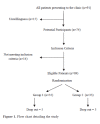Monochromatic Infrared Photo Energy versus Low Level Laser Therapy in Patients with Knee Osteoarthritis
- PMID: 25653818
- PMCID: PMC4281991
Monochromatic Infrared Photo Energy versus Low Level Laser Therapy in Patients with Knee Osteoarthritis
Abstract
Introduction: Knee osteoarthritis (KO) is the most common joint disease for which there is no optimal treatment. Monochromatic infrared photo energy (MIPE) is a relatively new light modality used to reduce pain and increase circulation. Low Level Laser Therapy (LLLT) is another light modality used to reduce pain in KO.
Methods: The aim of this study was to compare the effects of the MIPE and LLLT in improving pain and function in KO. Sixty participants with KO completed the program and were randomly assigned into two groups. Group 1 (experimental, n=30) received MIPE and exercises. Group 2 (control, n=30) received LLLT and exercises. Both groups received two visits per week for six weeks. Outcome included pain intensity measured on a visual analogue scale and physical function measured with the lower extremity functional scale, before and after the 12 therapy sessions (6 weeks after the start of the intervention).
Results: There were statistically significant improvements in pain intensity and lower extremity functional scale scores (p<0.05) in each group. However, no significant differences were recorded between the groups (p>0.05).
Conclusion: Therefore, MIPE and LLLT reduce pain and improve function in KO; however, there are no differences between the two modalities in reducing pain and increasing physical function in KO.
Keywords: LLLT; knee; light; monochromatic; osteoarthritis; pain.
Similar articles
-
Monochromatic Infrared Photo Energy Versus Low Level Laser Therapy in Chronic Low Back Pain.J Lasers Med Sci. 2015 Fall;6(4):157-61. doi: 10.15171/jlms.2015.11. Epub 2015 Oct 27. J Lasers Med Sci. 2015. PMID: 26705460 Free PMC article.
-
Long-term results of a randomized, controlled, double-blind study of low-level laser therapy before exercises in knee osteoarthritis: laser and exercises in knee osteoarthritis.Clin Rehabil. 2018 Feb;32(2):173-178. doi: 10.1177/0269215517723162. Epub 2017 Aug 4. Clin Rehabil. 2018. PMID: 28776408 Clinical Trial.
-
Effect of low-level laser therapy (904 nm) and static stretching in patients with knee osteoarthritis: a protocol of randomised controlled trial.BMC Musculoskelet Disord. 2015 Sep 14;16:252. doi: 10.1186/s12891-015-0709-9. BMC Musculoskelet Disord. 2015. PMID: 26369333 Free PMC article. Clinical Trial.
-
Low level laser therapy for osteoarthritis and rheumatoid arthritis: a metaanalysis.J Rheumatol. 2000 Aug;27(8):1961-9. J Rheumatol. 2000. PMID: 10955339
-
Review of Literature on Low-level Laser Therapy Benefits for Nonpharmacological Pain Control in Chronic Pain and Osteoarthritis.Altern Ther Health Med. 2018 Sep;24(5):8-10. Altern Ther Health Med. 2018. PMID: 28987080 Review.
Cited by
-
Photobiomodulation: lasers vs. light emitting diodes?Photochem Photobiol Sci. 2018 Aug 8;17(8):1003-1017. doi: 10.1039/c8pp90049c. Photochem Photobiol Sci. 2018. PMID: 30044464 Free PMC article.
-
Efficacy of Acupoints Dual-Frequency Low-Level Laser Therapy on Knee Osteoarthritis.Evid Based Complement Alternat Med. 2020 Sep 24;2020:6979105. doi: 10.1155/2020/6979105. eCollection 2020. Evid Based Complement Alternat Med. 2020. PMID: 33029170 Free PMC article.
-
Full-Body Photobiomodulation Therapy Is Associated with Reduced Sleep Durations and Augmented Cardiorespiratory Indicators of Recovery.Sports (Basel). 2022 Jul 31;10(8):119. doi: 10.3390/sports10080119. Sports (Basel). 2022. PMID: 36006085 Free PMC article.
-
Monochromatic Infrared Photo Energy Versus Low Level Laser Therapy in Chronic Low Back Pain.J Lasers Med Sci. 2015 Fall;6(4):157-61. doi: 10.15171/jlms.2015.11. Epub 2015 Oct 27. J Lasers Med Sci. 2015. PMID: 26705460 Free PMC article.
-
Guidelines versus evidence: what we can learn from the Australian guideline for low-level laser therapy in knee osteoarthritis? A narrative review.Lasers Med Sci. 2021 Mar;36(2):249-258. doi: 10.1007/s10103-020-03112-0. Epub 2020 Aug 8. Lasers Med Sci. 2021. PMID: 32770424 Free PMC article. Review.
References
-
- Gross KD, Hillstrom H. Knee osteoarthritis: primary care using noninvasive devices and biomechanical principles. Med Clin North Am. 2009;93(1):179–200. - PubMed
-
- Murphy L , Helmick CG . The impact of osteoarthritis in the United States: a population-health perspective. Am J Nurs. 2012;112(3 Suppl 1):S13–S19. - PubMed
-
- Hale LA, Waters D, Herbison P. A randomized controlled trial to investigate the effects of water-based exercise to improve falls risk and physical function in older adults with lower-extremity osteoarthritis. Arch Phys Med Rehabil. 2012;93(1):27–34. - PubMed
-
- Wallis JA, Webster KE, Levinger P, Fong C, Taylor NF. A pre-operative group rehabilitation program provided limited benefit for people with severe hip and knee osteoarthritis. Disabil Rehabil 2014; March 16: PubMed PMID: 24597936. - PubMed
-
- Atamaz FC, Durmaz B, Baydar M, Demircioglu OY, Iyiyapici A. et al. Comparison of the efficacy of transcutaneous electrical nerve stimulation, interferential currents, and shortwave diathermy in knee osteoarthritis: a double-blind, randomized, controlled, multicenter study. Arch Phys Med Rehabil. 2012;93(5):748–56. - PubMed
LinkOut - more resources
Full Text Sources
Research Materials

